BLI is a label-free detection method that relies on white light reflection from the surface of a biosensor tip.
It examines how the interference pattern of white light reflected from the tip changes when biomolecules attach to it. This shift is measured in nanometers and is documented in real time. It varies with the number and size of biomolecules bonded to the tip.

Image Credit: Gator Bio, Inc.
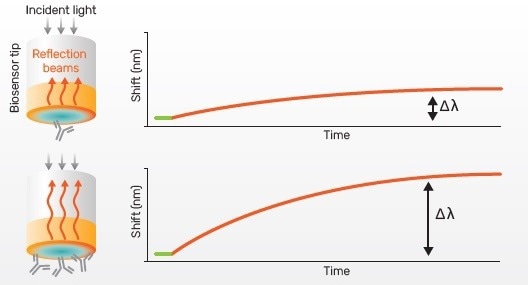
Image Credit: Gator Bio, Inc.
One tool. Many answers
The Gator® Biolayer Interferometry system analyses biological molecules in real-time to aid in multiple stages of therapeutic development.
The Gator® Pro instrument is crafted for high-throughput kinetics, epitope binning, and accurate quantitation during antibody development.
The device also encourages viral vector analytics by analyzing capsid titers of multiple AAV serotypes and determining empty versus full (E/F) content.
The Gator® Pro instrument increases walk-away time while providing quick, dependable, and high-quality data.

Image Credit: Gator Bio, Inc.
Gator® Pro features
The Gator® Pro instrument is intended for quick, automated, high-throughput analysis.
High-frequency parallel measurement of up to 32 samples is possible with 32 spectrometers.
Three sample plates allow for automated data acquisition for 1152 samples per batch.
The Gator® Pro system offers accurate, high-sensitivity data using Gator Bio next-gen biosensors.
Highlights
- Rapid biomolecule characterization
- High throughput, high-frequency parallel data acquisition of 32 samples
- Flexible 3 × 96 or 3 × 384-well format
- Automated data acquisition and processing of up to 1152 samples per batch

The Gator® Pro instrument accommodates three sample plates of either 96 or 384-well format. A fourth plate is reserved for biosensors and regeneration. Image Credit: Gator Bio, Inc.

Image Credit: Gator Bio, Inc.
Epitope binning

Three epitope binning formats on Gator® Pro. Image Credit: Gator Bio, Inc.

32 × 32 mAb competition matrix performed in less than 8 hours. Image Credit: Gator Bio, Inc.
In just eight hours, the Gator® Pro system can accomplish 32 × 32 epitope binning in a single automated tandem or classical sandwich assay.
Gator® Navigator software powers the workflow. Simple data visualization and presentation make interpretation simple. A larger binning matrix can be created by combining multiple assays. The report for one 96 × 96 competition profile can be completed in less than 5 days by integrating eight 32 × 32 binning assays.
Highlights
- 32 parallel competitive reactions in 10 minutes
- Single 32 × 32 EP assay in less than eight hours
- Extensive suite of biosensors for both sandwich and tandem format
- 96 × 96 report in five days
High throughput kinetics
The Gator® Pro system can determine the kinetics of a drug molecule binding to its target.
For antigen-antibody interactions, association rates (kon), dissociation rates (koff), and equilibrium dissociation constants (KD) can be calculated with or without the use of labeled reagents. The ultra-stable baseline improves the quality of high-affinity kinetic data even more.
The Gator® Pro system, with 32 high-frequency parallel measurements, facilitates high throughput primary screening of antibody libraries. A wide range of biosensors and assay configurations can accurately determine off-rate ranking in crude media and complete binding characterization of a purified antigen-antibody binding pair.
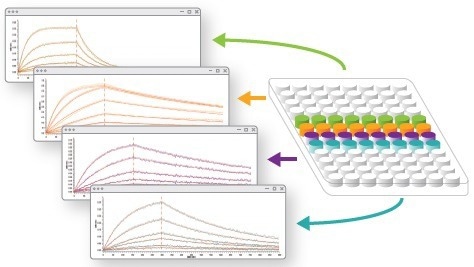
Kinetic sensorgrams of 4 different biosimilars in a single run. Image Credit: Gator Bio, Inc.
Highlights
- High-frequency parallel determination of 32 different binding reactions
- The rapid binding constant determination within 10 minutes
- Analyte concentration ranges that can be customized for precise results
- A broad range of biosensors to support multiple kinetic assay configurations
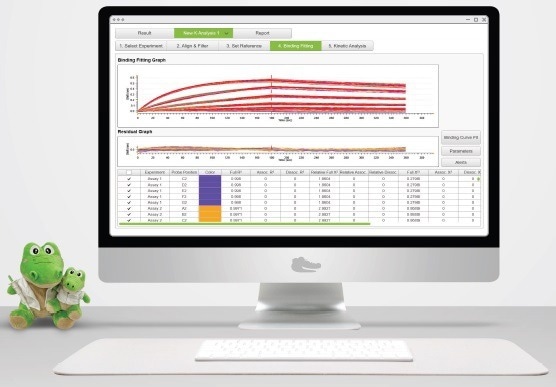
Gator® Pro system enables 32 parallel acquisitions for high-quality screening and pairing readouts. Image Credit: Gator Bio, Inc.
Antibody quantitation
The Gator® Pro system’s ability to read 8, 16, 24, or 32 wells in parallel allows for a versatile assay design that maximizes analytical throughput.
The 32-biosensor mode allows for rapid whole-plate quantitation of 96 or 384 samples in as little as 12 or 32 minutes instead of hours.
1152 samples can be analyzed per batch using only 32 biosensors and on-board regeneration.
Performance
Table 1. Accurate and precise data for 1152 human IgG sample analysis using Gator Bio Protein A biosensors. Source: Gator Bio, Inc.
Known conc.
(μg/mL) |
Calculated conc. (μg/mL) |
Binding rate |
Standard deviation |
% CV
(n = 144) |
| 700 |
704 |
1.2888 |
0.0541 |
4% |
| 300 |
297.79 |
0.7435 |
0.0344 |
5% |
| 100 |
103.74 |
0.297 |
0.0159 |
5% |
| 30 |
28.35 |
0.0807 |
0.0045 |
6% |
| 10 |
10.14 |
0.026 |
0.0012 |
5% |
| 3 |
3.19 |
0.0069 |
0.0004 |
6% |
| 1 |
0.98 |
0.0016 |
0.0001 |
9% |
Highlights
- 5-log dynamic range for titer determination
- 32 simultaneous biosensors offer unrivaled titer throughput
- Up to 1152 samples per batch from three sample plates
- Ready for integration with plate handler for extended walk-away operation
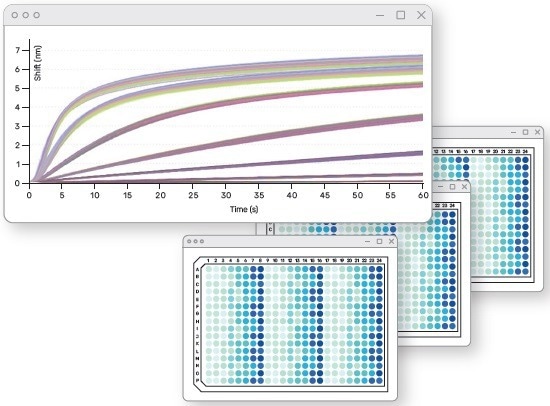
Heat map generated by software for human IgG concentration analysis using Gator Bio Protein A biosensors. Image Credit: Gator Bio, Inc.
Viral vector analytics
The Gator® Pro system determines AAV capsid titer and empty/full ratios quickly and accurately.
Distinct AAV serotypes, including chimerics, can be measured from crude media and purified samples using a simple “dilute and dip” workflow.
When compared to multiple techniques, such as ELISA, PCR, and AUC used for the same analysis, the high throughput Gator® Pro enables analytics on a single platform.
Performance
Table 2. Dynamic range and reproducibility of AAV9 titer with high sensitivity AAV9 kit. Source: Gator Bio, Inc.
Known conc.
(vp/mL) |
Calculated conc. |
Standard deviation |
% CV
(n=6) |
| 1.00E+09 |
8.70E+08 |
3.50E+07 |
4% |
| 5.00E+08 |
5.31E+08 |
4.87E+07 |
9% |
| 2.50E+08 |
2.78E+08 |
1.91E+07 |
7% |
| 1.25E+08 |
1.31E+08 |
6.06E+08 |
5% |
| 6.25E+07 |
6.60E+07 |
2.90E+06 |
4% |
| 3.13E+07 |
3.06E+07 |
2.69E+06 |
3% |
| 1.56E+07 |
1.58E+07 |
5.37E+05 |
9% |
| 7.80E+06 |
7.60E+06 |
3.95E+05 |
5% |
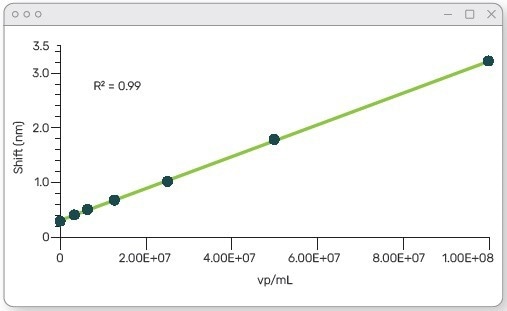
HS AAV kit standard curve for AAV5. Image Credit: Gator Bio, Inc.
Highlights
- High throughput crude sample analytics
- “Dilute and dip” workflow for upstream titer determination from complex matrices
- 96 upstream titer samples completed in 100 minutes
- Up to 32 E/F ratio determinations
- Easily customizable assays
- Compatible with all serotypes, including chimerics
Gator® Pro specifications
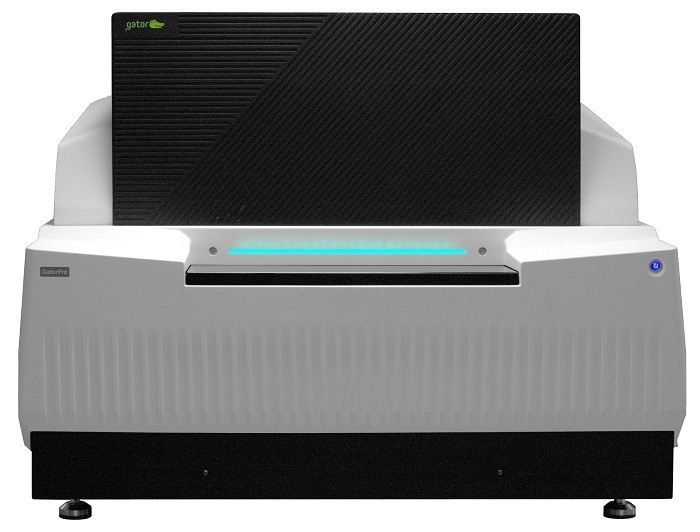
Image Credit: Gator Bio, Inc.
General
Table 3. Source: Gator Bio, Inc.
| . |
. |
| Detection |
Biolayer Interferometry |
| Microplate positions |
4 total (3 x 96- or 384-well microplates and 1 x Max Plate) |
| Sample type |
Proteins, antibodies, peptides, nucleic acids, liposomes, viruses, and small molecules |
| Maximum sample capacity |
1152 |
| Software |
Integrated |
| Simultaneous reads |
8, 16, 24, and 32 |
| Spectrometers |
32 |
| Acquisition rate |
2, 5, and 10 Hz |
| System baseline drift |
≤ 0.015 nm/hr |
| Dimension (H x W x D) |
84 x 114 x 77 cm |
| Weight |
220 kg |
| Automation compatible |
Yes |
| Orbital flow |
100 – 2000 rpm |
| Analysis temperature range |
Ambient plus 4 °C to 40 °C |
Kinetics
Table 4. Source: Gator Bio, Inc.
| . |
. |
| Analysis time |
Real-time kinetic binding from 5 min to 4 hr |
| Baseline noise (RMS) |
≤ 4 pm (8-32 biosensors) |
| Baseline drift |
≤ 0.1 nm/hr |
| Association rate (kon) |
101 to 107 M-1 s-1 |
| Dissociation rate (koff) |
10-6 to 10-1 s-1 |
| Affinity constant (KD) |
1 mM - 10 pM |
| Molecular weight |
>150 Da (8-32 biosensors) |
Quantitation
Table 5. Source: Gator Bio, Inc.
| . |
. |
| Analysis time |
32 samples in 2 min, 1152 samples in 142 min |
| Quantitation range (Protein A Biosensor) |
0.02 – 2000 μg/mL |
| Quantitation precision |
CV < 10% |
| AAV upstream analysis |
96 samples in 100 min |
Epitope binning
Table 6. Source: Gator Bio, Inc.
| . |
. |
| Analysis time |
Single run with 32 x 32 less than 8 hr |
| Pairing format |
In-tandem, classical sandwich and pre-mix |
| Binning capacity |
32 x 32 |
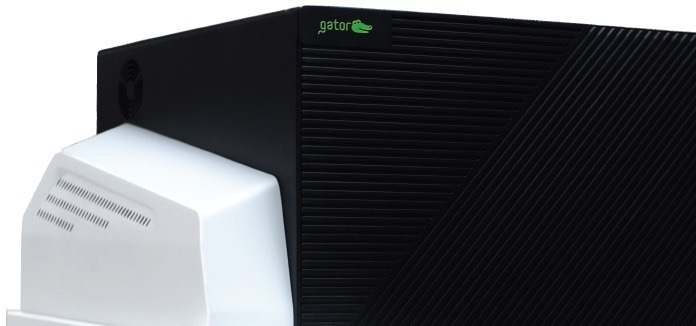
Image Credit: Gator Bio, Inc.
The patented Gator® solution for biotherapeutics discovery includes BLI instruments, biosensors, chemistry, and software.
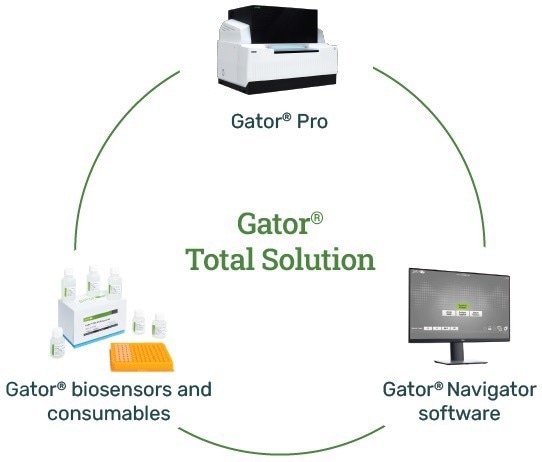
Image Credit: Gator Bio, Inc.